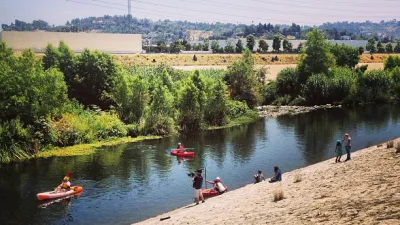The flood management story of Boulder, Colorado, includes a successful encounter with a 1,000-year rain event, and its lessons are less about concrete and dams than one might think.

Will Doig writes a detailed long read about the disparate experiences of last fall’s flooding in Colorado, when tried and true flood plan maps proved inadequate to the scale of a 1,000-year rain event, but a more subtle approach to flood control proved successful.
Boulder escaped some of the brunt of the storm but also a lot of potential damage by “focusing not on large engineering solutions, but more on good land-use planning and stewardship.”
“The philosophy was clear: A light touch tends to be more effective than a heavy hand. For instance, in the bed of Boulder Creek, drop structures were created out of rocks where the elevation of the creek falls sharply — small waterfalls that concentrate the flow of the water inward to keep it from overflowing its banks. Similarly, placed at strategic points near the sides of the creek were jagged rocks called “rip rap” that disrupt the momentum of the flood. These mechanisms are still found in the creek today, many of them placed near bridges to try to tame the water where it might do the most structural damage.”
A lot of that philosophy comes from Boulder’s relationship with its waterway, according to David Driskell, Boulder’s executive director for community planning and sustainability: “We don’t do large trapezoidal concrete channels to try to protect life in a flood. We understand our creek is an amenity that people value the 99.9 percent of the time that it’s not flooding.”
FULL STORY: You Can’t Stop Urban Flooding

Analysis: Cybertruck Fatality Rate Far Exceeds That of Ford Pinto
The Tesla Cybertruck was recalled seven times last year.

National Parks Layoffs Will Cause Communities to Lose Billions
Thousands of essential park workers were laid off this week, just before the busy spring break season.

Retro-silient?: America’s First “Eco-burb,” The Woodlands Turns 50
A master-planned community north of Houston offers lessons on green infrastructure and resilient design, but falls short of its founder’s lofty affordability and walkability goals.

Test News Post 1
This is a summary

Analysis: Cybertruck Fatality Rate Far Exceeds That of Ford Pinto
The Tesla Cybertruck was recalled seven times last year.

Test News Headline 46
Test for the image on the front page.
Urban Design for Planners 1: Software Tools
This six-course series explores essential urban design concepts using open source software and equips planners with the tools they need to participate fully in the urban design process.
Planning for Universal Design
Learn the tools for implementing Universal Design in planning regulations.
EMC Planning Group, Inc.
Planetizen
Planetizen
Mpact (formerly Rail~Volution)
Great Falls Development Authority, Inc.
HUDs Office of Policy Development and Research
NYU Wagner Graduate School of Public Service




























